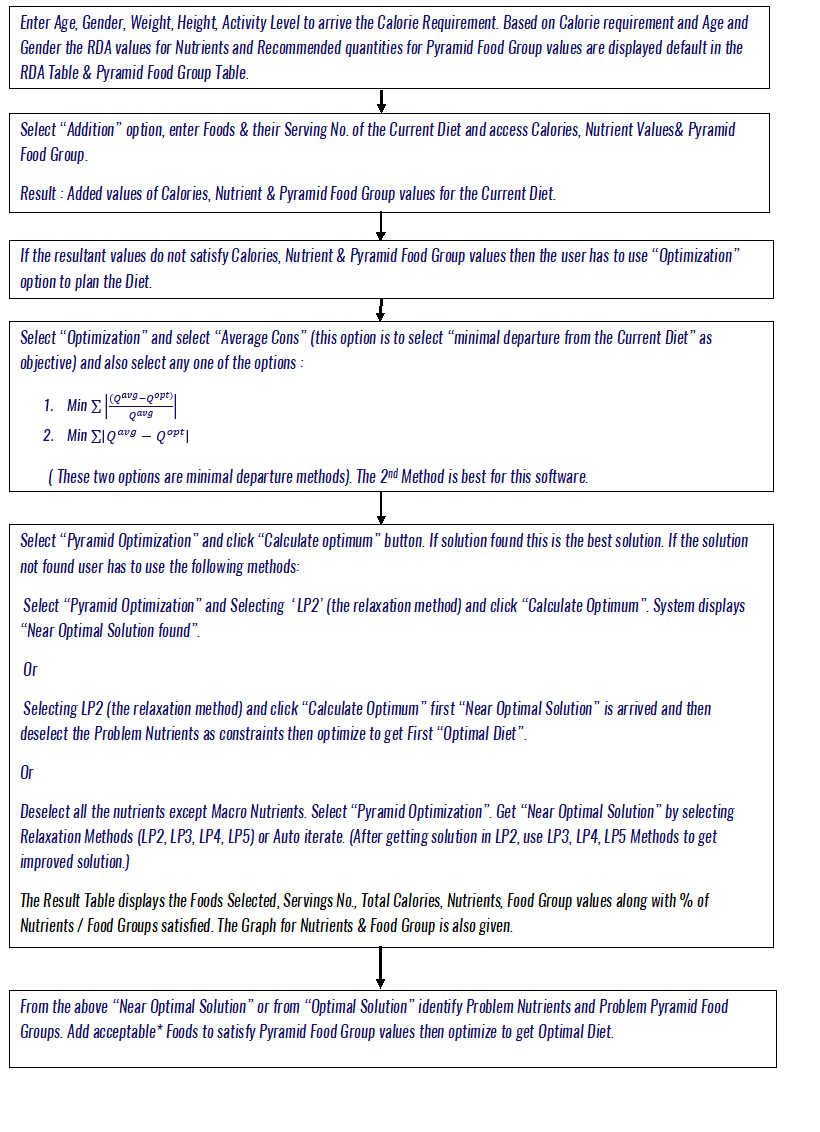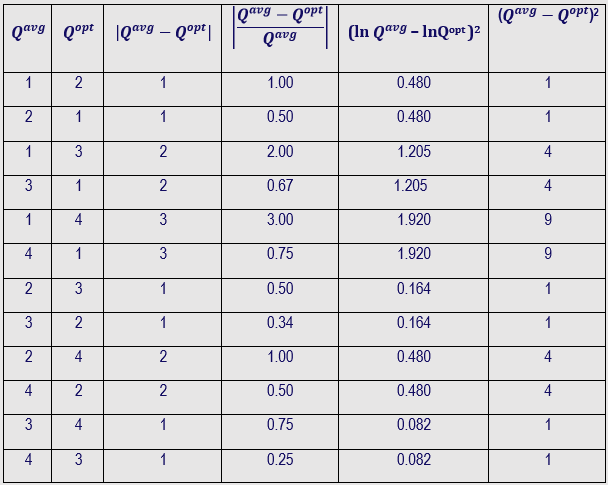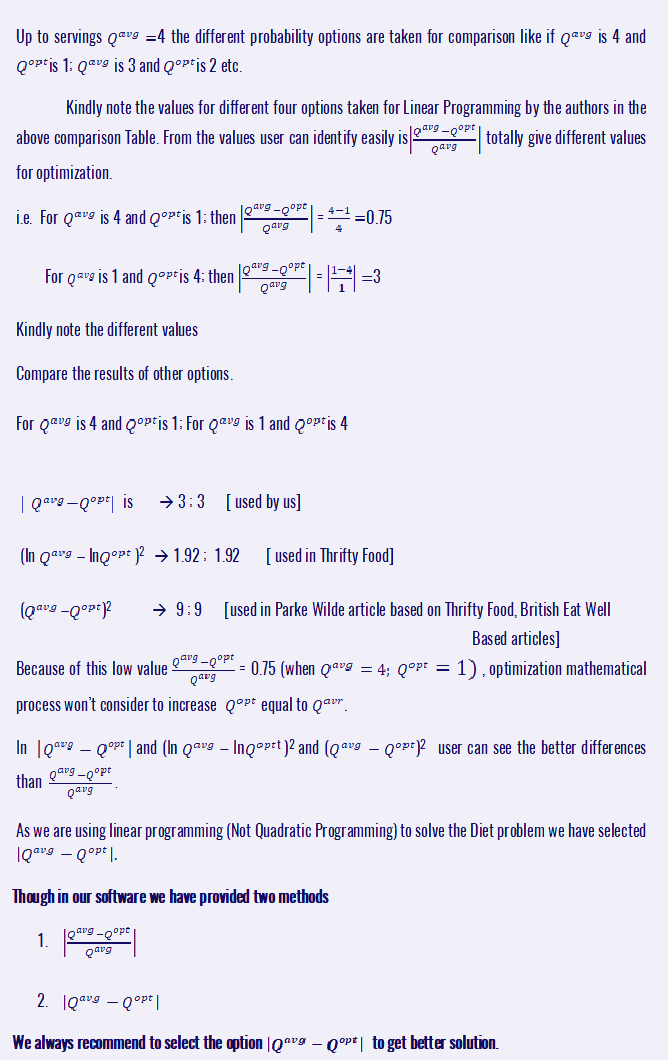- What is optimization Linear Programming ?
- Objective Function is- Minimize / Maximize the Total Energy (Calorie) or Minimize the Departure from Current Diet or Minimize the Cost of the Food.
- The Variables are Foods
- The Coefficient of variables are the Serving No. of Foods
- The Constraints are the Nutritional Requirement.
- Why optimization used in designing Diet Plan?
- What types of Diet Planning are possible in "Nutrioptimizer" ?
- Diet Plan Based on Calorie + 7 Pyramid Food Groups only
- Diet Plan Based on Calorie + 3 Macro Nutrients + 7 Pyramid Food Groups
- Diet Plan Based on Calorie + 7 Pyramid Food Groups + 32 Macro & Micro Nutrientsor selected Nutrients
- Diet plan Based on Calorie + 32 Nutrients or selected Nutrients
- Diet Plan Based on the following optimization method options :
A. Minimal Departure from Observed / Average Diet as Objective
B. Minimal Departure from Observed / Average Diet as Constraint with range
C. Minimal Departure from Observed / Average Diet as Objective + Constraint with range
D. Calorie as Objective & remaining as Constraints ( without "Minimal Departure from Observed Diet")E. Anyone of Macro & Micro Nutrients as Objective and the remaining as Constraints (without "Minimal Departure from Observed Diet" )In this option the following types of optimizations are possible:a) Carbohydrate or Protein or Fat is selected as Objective and Minimization & Maximization of the Macro Nutrients are possible i.e. Minimization of Carbohydrate or Fat or Maximization of Protein is possible.For example :
- Carbohydrate Low Diet Plan from the Chosen Foods
- Fat Low Diet plan from the Chosen Foods
- SFA Low Diet Plan from the Chosen Foods
- PUFA High Diet Plan from the Chosen Foods
- Fiber High Diet Plan from the Chosen Foods
- Protein High Diet Plan from the Chosen Foods.....etc., in total 17 options.
b) Any one of the Micro Nutrients is selected as Objective and Minimization & Maximization are possible.For example :
- Folate High Diet Plan from the Chosen Foods
- Iron High Diet Plan from the Chosen Foods
- Potassium Low Diet Plan from the Chosen Foods
- Sodium Low Diet Plan from the Chosen Foods
- Selenium High Diet Plan from the Chosen Foods
- Vit A High Diet Plan from the Chosen Foods....etc. in total 42 options
- Which Food Databases does "Nutrioptimizer" use ? Food Databases included are :
- Which Nutrient Recommendations does "Nutrioptimizer" use ?
- India – ICMR ( Indian Council of Medical Research )
- U.S – IOM ( Institute of Medicine )
- Which Pyramid Food Group Recommendations does "Nutrioptimizer" use ?
- Indian Dietary Guidelines
- US Dietary Guidelines
- Can I Add Foods and Raw Foods to "Nutrioptimizer" ? Yes, you can add both Foods and Raw Foods to your "Nutrioptimizer" Database for your own use. Bulk Food Datas can be imported from Excel. New Food can be added via "New Food" Addition option.
- Give a short explanation about procedure to get a Optimal Diet in "Nutrioptimizer" ? Diet Planning using Nutrioptimizer
- Why there are two options given for Minimal Departure from Average Diet Calculations? Which is the Best? As many Authors used
- Give simple explanation about infeasible Diet problems in Linear Programming ? Linear Programming quickly and efficiently provides an optimal solution if all Nutritional Constraints met the requirements (i.e. RDA & Recommended Food Group values).
- What are the acceptability factors considered in Nutrioptimizer ?
A mathematical technique for finding a minimum or maximum
value of a function of several variables subject to a set of constraints as linear programming.
Linear Programming in Diet Planning :
Linear Programming in Diet Planning :
Simultaneously dietary achievement of full set of Nutrient Recommendations and Pyramid Food Group
Recommendations is difficult.
Diet optimization model using Linear Programming is a useful mathematical means of translating Nutrient,
Pyramid Food Group
Recommendation into realistic nutritionally optimal food combinations incorporating Current / Observed / Average Diet Foods.
Using Linear Programming model, user can identify optimal Diet providing practical Food choices, and meeting Nutrient and
Pyramid Food Group Recommendation.
It is a Auto Dietary modifications from current eating habits to fulfill nutritional goals.
USDA SR 28 – 32 Nutrient values
USDA with FPID – 32 Nutrients + 5 Major Food Groups + Oil & Fat , Added Sugar
India – Food Datas – 32 Nutrients + Food Group values
India Raw – Raw Food Data – 32 Nutrients + Food Group values
To arrive at a Diet Plan satisfying Calorie , Nutrient Requirement along with Pyramid Food Group Recommended values.

In order to improve the acceptability of the outcomes of Diet Planning , only Foods reported in his/her daily/weekly record is to be used.
Note :
Optimization means Auto selection of foods from current diet satisfying calorie requirement and nutrient & Pyramid Food Group recommended values. If these recommended values not satisfied add "acceptable foods" to Current Diet & then optimize user will get the Optimal Diet or Reasonably Good Diet.
Selection of "Acceptable Foods" is easy using this Software
As Pyramid Food Group values are already arrived for the first Optimal Diet Based on Current Diet the "Acceptable Foods" can be easily identified from the Pyramid Food Group values of the Optimized Diet .
In simple terms for a specific calorie requirement if we take foods as per Dietary Guidelines (which recommend the quantity of food from each Pyramid Food Group) the RDA for nutrient will meet.
In the First optimized Diet based on Current Diet, if Food Group Grains shortage is there, then add required quantity of grains oriented Foods; and if Fruits shortage add fruits; If vegetable shortage add vegetables; if Milk shortage then add milk. . (For excess in Pyramid Food Group, decrease the food quantity of that particular Pyramid Food Group as explained above.)
Like this relevant food can be selected and then optimized to get the Final Optimal Diet satisfying Nutrient & Pyramid Food Group values.
 for the optimization we also provide this method.
for the optimization we also provide this method.We recommend to use
 for the optimization using our software.
for the optimization using our software.Detailed Explanation:
Comaparison of Equation /Algorithm used in arriving optimal Diet with Minimal departure from the current Diet is in the following table

We are using number of servings for the food quantity and most of the researchers used grams for the food quantity.
So, comparison between different algorithms used to arrive optimum solution is done to have a clear idea of which algorithm is the best.
In most of the articles, authors used


If one or some of the Nutritional Constraints are not met the requirements then it is infeasible.
The reason is the Current Diet / Selected Foods (for optimization) could not meet one or some of the requirements (i.e. RDA & Recommended Food Group values).
That is even one of Nutrients is not met (like 1% Excess or Low of RDA) then also this is infeasible Diet problem !! ( This is the crude face of the Linear Programming ? ?)
If user understand this then finding the Optimal Solution ( by the methods provided in Nutrioptimizer) is easy for the user.
For example the Fat value is slightly higher than the RDA value ( in the Current Diet / Selected Foods) then solution will not come. This is Infeasible Problem.
For example "Iron" value is slightly lower than the RDA value ( in the Current Diet / Selected Foods ) then solution will not come. This is also a Infeasible Problem.
Normal Methods used in solving infeasible problems are
1. Adding / Deleting / Exchanging Foods, increasing / decreasing the serving No. of existing foods
[ It is a Trial & Error Method. So time consuming ] 2. Some of the Nutrient and Pyramid Food Group Constraints are not considered for optimization [ In this method also which constraints ( Nutrient & Food Group) are not to be considered is also a Trial & Error Method and time consuming]
Normally in all Diet Problems some of Nutrients and one or two Food Group values will not satisfy with some minimum percentage Lower or Higher than the requirement. Sometime that value is OK for Nutritionist and user.
But Linear Programming says it is infeasible.
In Nutrioptimizer 32 Nutrients and 7 Pyramid Food Groups, total 39 constraints are considered.
Satisfying 39 Constraints is real challenging problem. So only we are forced to identify "Auto
Methods" to solve the infeasible problems.
The key features of Nutrioptimizer in solving infeasible problem follows :
Auto Methods [Less time consuming Methods] :
i. Auto Constraint Elimination.ii. Constraint Relaxation Methods [ LP1, LP2, LP3, LP4 LP5].
iii. RDA Relaxation Method.
iv. Changing option for Serving "Size for LP" ( 0.25, 0.5, 0.75, 1, Actual ).
Manual Methods (Time Consuming Method) :
1.User can shift to Addition Software by selecting "Addition" above the RDA Table (The Food
names and Serving No. are Auto transferred for Current / Observed Diet) or2. User can see the "Added Food Value Table".
From the above two tables for the Current / Selected Foods user can easily identify which Nutrients / Food Group are Problem Nutrients / Food Group [ In "Addition" user can see easily the Problem Nutrients as "Iron Low", "Grains Low" like Intimations in the Result Table.
In the Added Food Value Table user has to see the Min & Max serving Total for each Nutrient / Food Group and identify the Problem Nutrients / Food Group]
After identifying the Problem Nutrient / Food Group from the above Auto / Manual methods, those Nutrient / Food Group should not be
considered for optimization. (By deselecting that Nutrient in LP column in the RDA Table, By deselecting that Food Group in LP Column in the Pyramid
Food Group Recommended Value Table.). After deselecting the problem Nutrients / Food Group 'Optimal Solution' can be found. This is not the final
'Optimal Solution'.
This is the first 'Optimal Solution' and this can be further improved (it is a must to improve the
Problem Nutrient / Food Group values to satisfy the Nutritional requirement) by Adding / Deleting
/ Exchanging Foods ; increasing / decreasing the serving No. of existing foods.This is easy in Nutrioptimizer because Food Group values are available in this Software.
For example "Grains" shortage "Grains" rich food can be added / Grains rich Food serving No. can be increased.
Logic behind this is for a Specific Calorie requirement if we take Foods as per Dietary Guidelines ( which recommends the quantity of food from each Pyramid Food Group) the RDA for Nutrients will be met.
Like this "Satisfied Optimal Solution" can be obtained.
"Satisfied Optimal Solution" need not to satisfy all the 39 Nutritional Constraints fully.
For Individual Diet:-
1. Current Diet can be entered in the "Avg Cons" Column2. Optimization based on minimal departure from the Current Diet [ Auto Dietary modification of Current Diet to get the Optimal / Balanced Diet ]
3. Only foods reported in individual's weekly regarded diet are to be used to fulfill a set of nutritional constraints.
4. Min Serving No. & Max Serving No. can be entered in this software.
Min Serving No. means the Minimum Serving No. of that food must be included in the Optimal Diet.
Max Serving No. means the Maximum Serving No. that is allowed in the Optimized Diet. Using these above options user can get the acceptable and realistic Diet Plan.
For Population Diet :-
1. Observed / Average Diet of population can be entered in the "Avg Cons" column.2. Optimization based on minimal departure from the Observed / Average Diet [ Auto Dietary modification of Observed / Average Diet to get the Optimal / Balanced Diet ]
3. Min Serving No. & Max Serving No. can be entered in this software.
In Min Serving No. column user can enter the 5th percentile of consumption observed in the Population.
This Min Serving No. means the Minimum Serving No. of that food must be included in the Optimal Diet.
Normally we advise user can enter zero for the Min Serving value for population Diet. For important food ( i.e. The food must be included in the Diet ) user can enter the Min Serving No.
In Max Serving No. column user can enter the 95th percentile of consumption observed in the population.
This Max Serving No. means the Maximum Serving No. of that food that is allowed in the Optimized Diet.
Using the above options user can get the acceptable and realistic Diet Plan.
